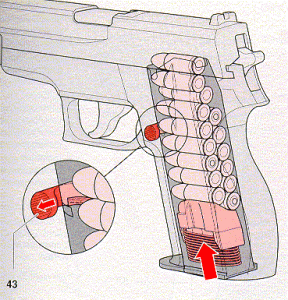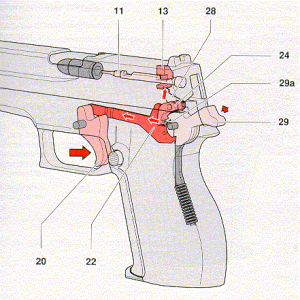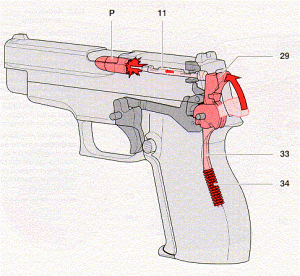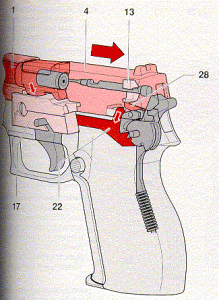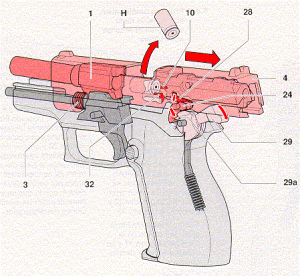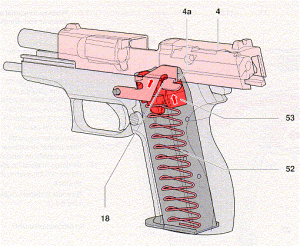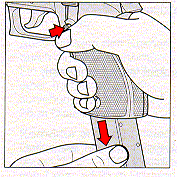General Information
We realise that not all visitors to this website are gun savvy, so here you will find some basic information on firearms and the firearms debate. If you are interested in further information, we strongly suggest you go to the links page and surf through some of the sites listed.
If firearms are dangerous, why do we need them?
Won’t the handgun ban prevent another “Dunblane”?
What is a firearm?
In law, a firearm is defined as “a lethal barrelled weapon of any description from which any shot, bullet or missile can be discharged”.
However, a better definition is that a firearm is an object with a barrel, through which a projectile or shot is discharged through the action of expanding gases from the burning of an explosive, or through the action of compressed air or gas which expands.
Firearms that are typically used by an individual can be divided into four categories. Each category is however broad:
1) “Handgun” – which includes a pistol, revolver, air pistol, muzzle-loading pistol, etc. This is a firearm without a shoulder stock which is held and fired from a person’s hand or hands, and is typically smaller than other types of firearm. Also, most handguns have rifled barrels. Rifling is ridges cut into the barrel upon which the bullet bears while travelling down the barrel, causing it to spin in flight. Rifling usually increases the accuracy of the bullet for this reason.
2) “Rifle” – a rifle is a firearm with a stock and a rifled barrel which is fired using both hands and is shoulder-mounted.
3) “Shotgun” – a shotgun is a firearm that usually has a smoothbore barrel and is fired from the shoulder using both hands. Unlike rifles and handguns, shotguns are usually used with shot shells, which contain multiple projectiles instead of one. Shotguns have a much shorter range than most rifles or pistols.
4) “Machineguns” – this covers firearms such as assault rifles, submachineguns etc. A machinegun is a firearm capable of firing successive shots with a single pull on the trigger.
When the gun is fired, the bullet travels down the barrel, but in addition the force of the cartridge case going in the other direction enables the gun to eject the empty case, and strip another round off the top of the magazine and into the chamber of the firearm, thus enabling it to fire automatically. Some machineguns use the expanding gases to cycle the action instead, usually through a gas port in the barrel which allows the gases to bear against a gas piston attached to the bolt.
“Semi-automatic” firearms are not machineguns, though they function in a similar way, but do not fire continuously when the trigger is pulled. Instead they simply use the energy of the fired round to cycle the action automatically for the next shot, but are designed so that the operator of the firearm must deliberately pull the trigger for each shot to be fired.
Many assault rifles and submachineguns have a selector switch so that they can function both as machineguns and also semi-automatically.
How does a firearm work?
The following illustrations and description show how a SIG-Sauer P225 9mm semi-automatic pistol work. There are dozens of different operating methods for firearms, but the basic principle of all is the same, the firearm must be loaded, the action cocked for firing, and the firing pin must strike the primer of the cartridge for it to fire:
1) A magazine is loaded with ammunition, and then inserted into the pistol until the magazine release button’s stop is engaged (43).
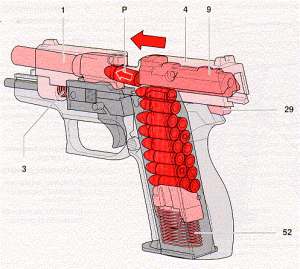 2) The slide (4) is then pulled back, which cocks the hammer (29), and is then released, and is pushed forward by the recoil spring (3). A round of ammunition (P) is stripped from the magazine by the breech block (9) and is fed into the barrel’s (1) chamber. The next round in the magazine is forced up by the magazine spring (52).
2) The slide (4) is then pulled back, which cocks the hammer (29), and is then released, and is pushed forward by the recoil spring (3). A round of ammunition (P) is stripped from the magazine by the breech block (9) and is fed into the barrel’s (1) chamber. The next round in the magazine is forced up by the magazine spring (52).
3) With the firearm now loaded, the trigger (20) can be pulled, which draws forward the trigger bar (22). This has the effect of pivoting the safety lever (28) forward which raises the firing pin safety block (13) allowing the firing pin (11) to move. At the same time, the trigger bar pulls forward the sear (24) from the notch (29a) on the hammer (29), releasing the hammer which is pushed forward by the main spring (34) and hammer strut (33), so that it strikes the rear of the firing pin (11) which hits the primer of the round of ammunition (P) causing it to fire.
4) After the round is fired, the force of the combustion while driving the bullet out of the barrel also forces the empty cartridge case backward, which is called “blowback”. This thrusts the slide (4) to the rear. The safety lever (28) and firing pin safety block (13) are separated activating the firing pin safety block. A protrusion on the top of the trigger bar (22) resting in a recess in the slide is forced downward as the slide moves rearward, forcing the trigger bar downward and disengaging it from the safety lever (28). As the slide travels rearward, it takes the barrel with it, until the barrel is stopped by the locking insert (17) which tilts it down and away from the slide.
5) As the slide continues its rearward travel, the sear spring causes the sear (24) and safety lever (28) to return to their original positions. The empty case (H) is extracted by the extractor claw (10) mounted in the slide and upon striking the nose of the ejector on the slide catch lever is ejected out of the ejection port in the slide. As the slide (4) recoils up to its stop, it cocks the hammer (29) which is caught in its notch (29a) by the sear (24). The slide is propelled forward by the recoil spring (3), and the next round is fed into the chamber of the barrel (1) as the slide locks up with the the barrel again. The pistol is now ready to fire again.
6) After the last round is fired, the slide (4) travels rearward and is held in the rearward position by the slide release lever (18) which is forced upward by the action of the magazine spring (52) and magazine follower (53). The lever is forced into the slide release notch (4a) on the slide. The empty magazine is ejected by pressing the magazine release button, and a fresh loaded magazine can be inserted. The gun is then made ready to fire by pressing down on the slide release lever (18) which strips a round off the top of the magazine and into the barrel’s chamber.
Aren’t firearms dangerous?
Most firearms, especially those designed for hunting and military use, are capable of causing fatal injuries, and are designed to do so. Safety rules for the handling of firearms should therefore be strictly adhered to:
1) Always keep your finger off the trigger until you are ready to shoot;
2) Never point a firearm at anything you do not wish to destroy;
3) Always be aware of whether your firearm is loaded or unloaded, and make sure by checking.
If firearms are dangerous, why do we need them?
Firearms are needed for a wide variety of reasons. They are commonly used to destroy pests, from small animals such as rabbits and squirrels up to much larger animals such as deer. Firearms are usually considered the most humane method of dealing with animal pests which must be destroyed, as they are more discriminate and certain than other methods such as traps or poison.
Firearms are also used for self-defence, whether it be by police officers, soldiers or private individuals. A firearm is the most effective method of self-defence usually, because it is an “equaliser”. A physically weak person would not ordinarily be able to defend themselves against a physically strong person, but a firearm enables the weak to defend themselves adequately.
Firearms also have other necessary uses, such as slaughtering instruments, or for veterinary use. Firearms also have a long-established use in a wide variety of sports, whether it be traditional bullseye target shooting, clay pigeon shooting, or deer stalking, or any of the many other shooting sports.
Won’t the handgun ban prevent another “Dunblane”?
The ban on handguns will most certainly not prevent another mass murder like the one at Dunblane Primary School, for the exact same reason the ban on self-loading and pump-action rifles after the Hungerford killings did not stop Dunblane; that is because (a) there are a wide variety of other legally possessed firearms which are just as lethal and (b) the prohibition of legally possessed firearms does not address illegally possessed firearms.
There are in Great Britain at least 700,000 people licensed to own firearms of one type or another. In addition, there are estimated to be at least 850,000 illegally possessed firearms in Great Britain, though most estimates are higher.
A firearm of any description can be used to commit mass murder, especially in a situation like Dunblane where most of the victims were young children.
Mass shootings throughout the world have been committed with all manner of firearms. The worst mass shooting known for example, occurred in Norway in 2011 when a man opened fire with a semi-automatic hunting rifle and shot dead 69 people. However, at the other end of the firearm spectrum, a mentally disturbed man in New Zealand shot dead six and seriously injured four more with an illegally possessed single shot shotgun in late 1996. In France in 1990, a man shot dead 14 people with a double-barrel shotgun.
Prohibiting firearms of one type or another will do nothing to prevent further similar crimes, because nearly all firearms are capable of being used to commit these crimes.
As a practical matter, it is also not possible to prohibit all firearms, because they have certain essential agricultural uses in addition to their sporting use, and a complete prohibition would still not address illegally possessed firearms. (Of course illegal possession would probably grow if legal possession were completely outlawed).
In our opinion, the solution to the misuse of firearms is to have a sensible regulatory environment for legally possessed firearms which is not needlessly punitive, which would encourage benign owners of illegally possessed firearms to possess them legally, and to seek out and prosecute those who would use firearms for illegal purposes to the fullest extent of the law. Committing a violent offence with a firearm should be cause for the most severe criminal penalties, which is currently not the case in the British Isles.
It should be noted that according to Home Office statistics, 86-89% of firearm-related homicides in England & Wales are committed with illegally possessed firearms.
(Postscript: since this was originally written there has been another mass shooting in the UK in Cumbria that was committed using a .22 rifle and a double-barrel shotgun, so it is clear the handgun ban was pointless.)
“He who would surrender an essential liberty to purchase temporary safety deserves neither.” – Benjamin Franklin (paraphrased into modern grammar)

